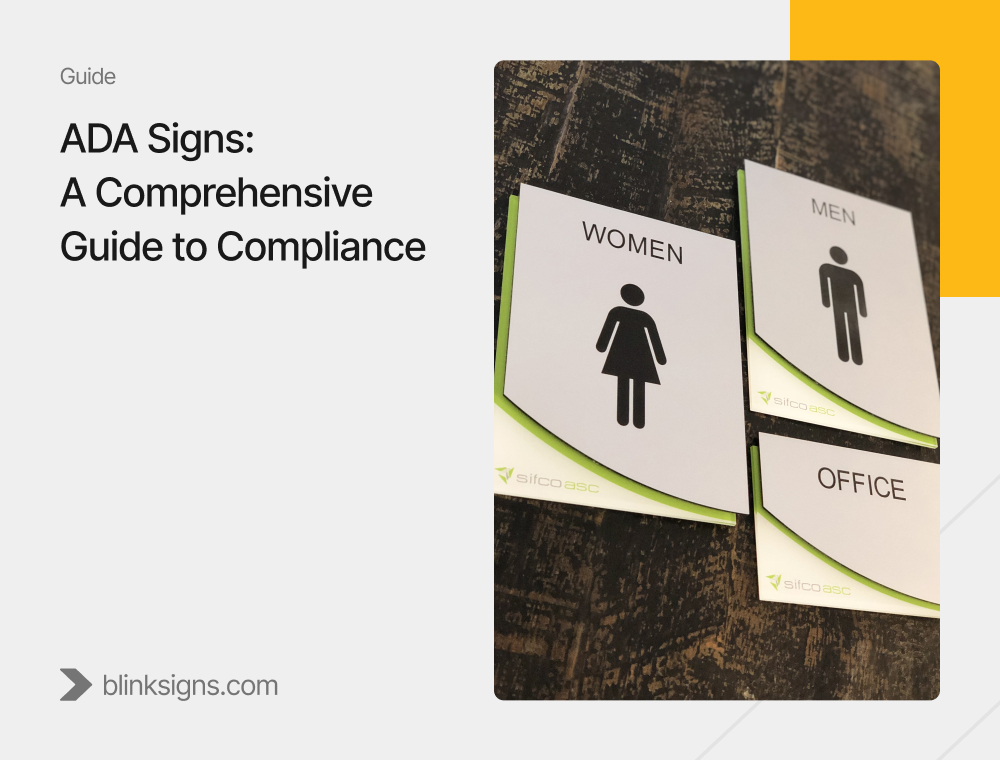
Is your business truly welcoming to everyone? In today’s world, accessibility is not just a good practice, it’s the law. The Americans with Disabilities Act (ADA) sets clear standards for signage to ensure that everyone, regardless of their abilities, can navigate your space with ease.
At BlinkSigns, we’re passionate about creating inclusive environments, and ADA-compliant signage is a crucial step in that direction.
ADA compliance goes beyond simply adding Braille to your signs. It involves careful consideration of various factors, including:
Compliance also means displaying symbols of accessibility such as the International Symbol of Access (wheelchair icon), which helps people instantly recognize accessible entrances, restrooms, and parking areas.
ADA signage covers a wide range of applications across permanent rooms, buildings, and facilities. Here are the most common categories:
These are essential for labeling permanent rooms in any facility, from offices to schools. Room ID signage helps visitors and staff easily locate room numbers, offices, meeting spaces, or classrooms.
👉 These custom ADA signs can be branded to fit your interiors while remaining fully compliant.
Restroom accessibility is one of the most visible parts of ADA compliance. Proper labeling with symbols of accessibility (like gender-neutral or wheelchair icons) is required for ADA compliant signs in all public facilities.
Parking signs are critical for compliance, particularly when reserving accessible spaces. Navigation and wayfinding signs help visitors move safely through complex buildings.
👉 Clear, compliant parking and navigation signs improve safety and show your commitment to inclusivity.
Regulatory signs help restrict access to certain areas, while safety signs prevent accidents and guide emergency responses. Many must include international symbols to ensure universal understanding.
These are vital in hospitals, schools, factories, and other facilities where compliance can prevent costly risks.
Using fonts that are too decorative or hard to read.
Insufficient contrast between text and background.
Incorrect placement (too high, too low, or blocked by furniture).
Braille that is missing, misplaced, or incorrect.
Forgetting specialized areas like parking signs and room numbers.
Navigating ADA requirements can be complex, but you don’t have to do it alone. BlinkSigns has extensive experience in designing and producing custom ADA signs that are both functional and aesthetically pleasing.
ADA compliant signs (or ADA compliant signs) adhere to the ADA regulations laid out in the 2010 ADA Standards for Accessible Design. They must have tactile raised characters, Grade 2 Braille, high contrast between text and background, a non-glare finish, and often include symbols of accessibility such as the International Symbol of Accessibility (ISA). These signs must also follow guidelines for font size, stroke width, and spacing to ensure legibility for all users.
ADA signage is required for all permanent rooms or spaces within buildings and facilities that are open to the public or contain employees — such as restrooms, meeting rooms, exit routes, elevators, and offices. Even small businesses must comply. Areas designated as permanent (even if not public) like staff workspaces and storage rooms also typically require proper ADA signage.
Yes—restroom signs that designate permanent rooms must include raised text, Grade 2 Braille, and the International Symbol of Accessibility if applicable. The ISA helps communicate accessibility visually and is considered a symbol of accessibility under ADA regulations.
Yes, ADA signage can incorporate branding — such as your logo, colors, and materials — as long as all ADA regulations are met. Fonts must remain sans-serif and readable, Braille must be properly placed beneath the corresponding text, and visual contrast must stay high. These are often referred to as custom ADA signs.
ADA signs should be mounted on the latch side of doors, between 48 and 60 inches above the finished floor, measured to the baseline of tactile characters. For consistency, many facilities center them around 54 inches from the floor. Adequate clear floor space (at least 18”x18”) should be provided for accessibility.
ADA sign compliance falls under federal law (Title III enforcement by the Department of Justice), but in practice enforcement is handled by local building inspectors. Fines for first-time violations may be substantial, and continued non-compliance can lead to higher penalties and even lawsuits.
Accessible parking signs must include the ISA (International Symbol of Accessibility) and, if the space is van accessible, wording like “Van Accessible.” These signs must be visible and at a correct mounting height, but Braille is typically not required on exterior parking signs unless they identify a permanent room or space.
Some common ADA signage mistakes include:
Using decorative or script fonts that aren’t legible;
Poor text-background contrast;
Omitting Braille or placing it incorrectly;
Mounting signs too high, too low, or on the wrong side of doors;
Forgetting important areas like parking signs or room numbers.
Avoiding these ensures better compliance and accessibility.
Contact BlinkSigns today for a free consultation. Let us help you create a welcoming environment for everyone with ADA-compliant signage that reflects your commitment to accessibility and excellence.